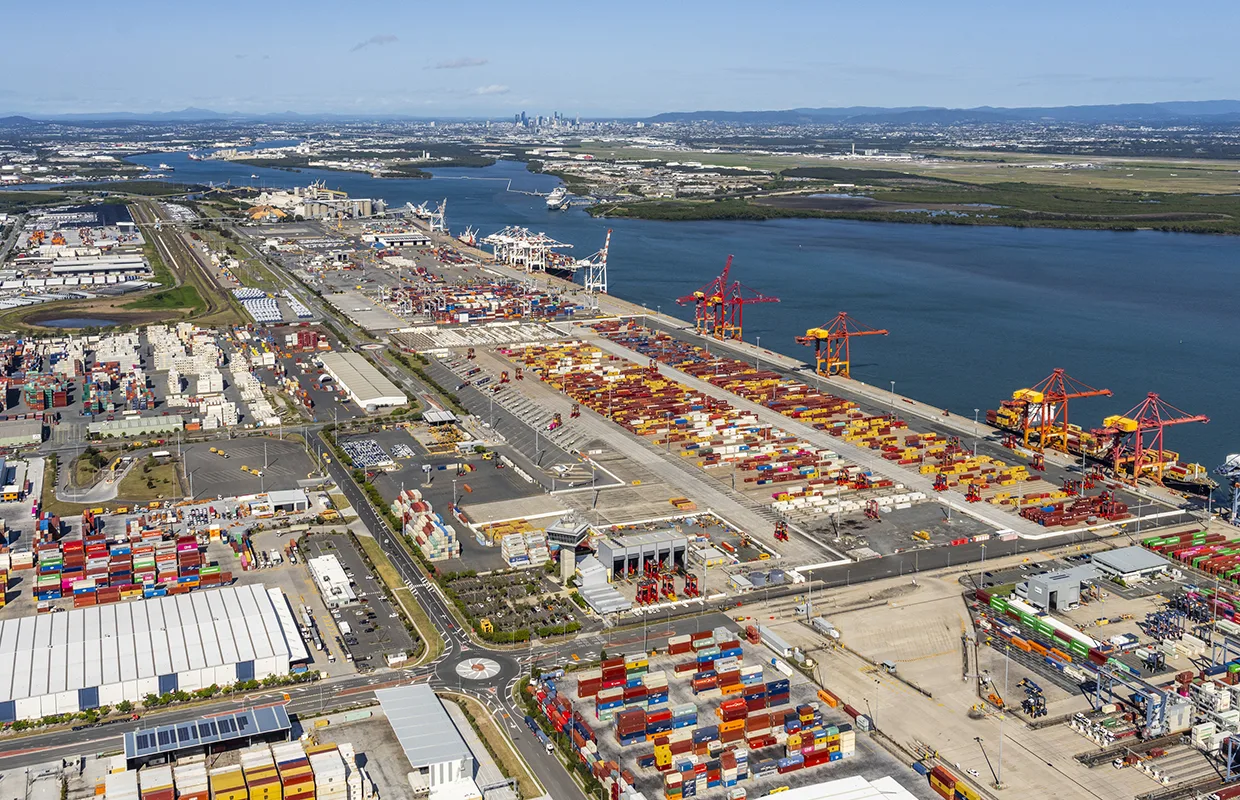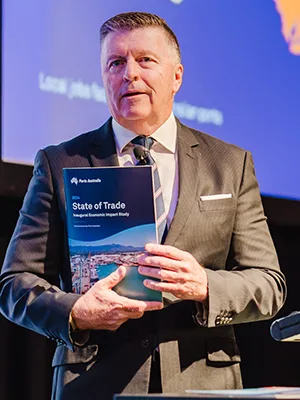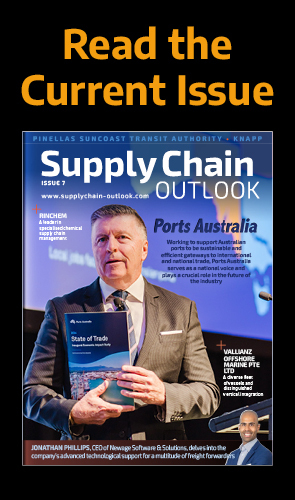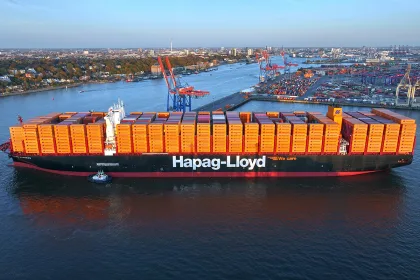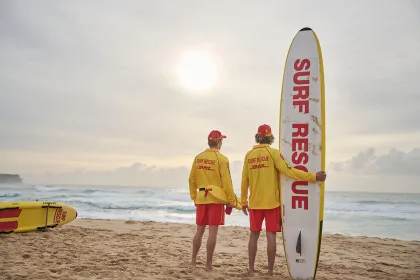As a robust island nation, Australia is not only heavily dependent on maritime shipping for its economy but also a major contributor to the international supply chain and port operations industries. We explore the current state of the sector more deeply and look at the qualities that make Australia stand out in the shipping trade.
AUSTRALIAN PORT AND LOGISTICS SPOTLIGHT
Australia, the largest sovereign nation in Oceania, is entirely surrounded by water and, therefore, an understandably crucial player in the ports industry.
With its extensive coastline and strategic position enclosed by the Indian and Pacific Oceans, the country is home to a multitude of major ports that have an unparalleled impact on both the national and regional economies.
The country’s geographic position in the South Pacific makes it accessible to many other nations through some of its most prominent ports, including Sydney Harbour and the Ports of Melbourne, Brisbane, Fremantle, and Darwin – alongside many others.
As the key to international trade and global connectivity, these Australian ports are true engines of the economy and are only continuing to grow in importance as dependence upon maritime trade steadily increases.
The ports are also recognised for their ability to handle many different types of cargo, from agricultural products to highly technological shipping containers. This variety reflects the country’s economic strength and viability as well as the crucial significance of having reliable trade relationships across the globe in an increasingly connected world.
However, despite their unparalleled importance, international ports like those across Australia are facing various challenges, such as congestion, security, and environmental sustainability, which need to be addressed via efficient management and innovation.
Specifically, to ensure these ports stay competitive, the adoption of new technologies is necessary to allow for optimised port operations, improved security, and reduced environmental harm caused by such a titanic and expansive industry.
Additionally, the private sector will continue to be a major player in port operations and investment, with the regulatory framework set out by both the national governmental bodies and local governmental entities.
Known for its vast expanses, wondrous natural diversity, and sturdy economy, the island nation of Australia has a robust history of being a major player in the shipping and ports industry and will continue to remain a global leader in maritime activities even as the sector undergoes transformation.
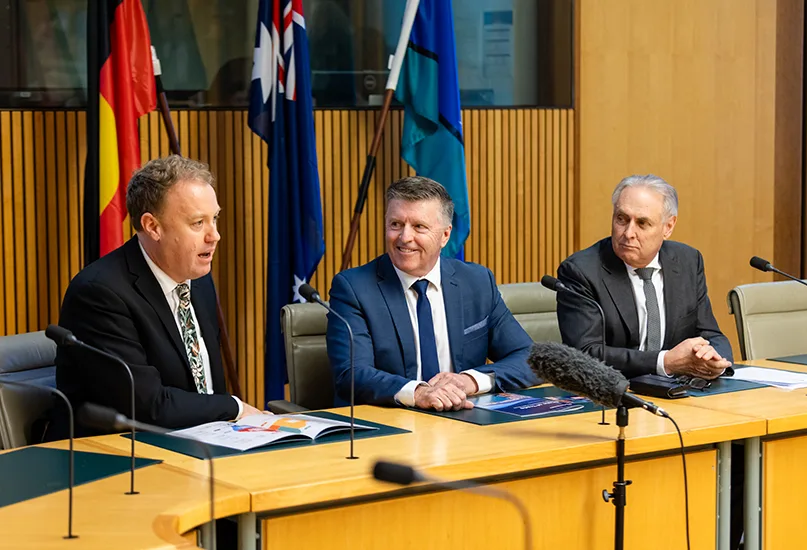
Q&A WITH PORTS AUSTRALIA
Working to support Australian ports to be sustainable and efficient gateways to international and national trade, Ports Australia serves as a national voice and plays a crucial role in the future of the industry. We revisit the organisation with Mike Gallacher, CEO, to discuss further.
Ports Australia is one of Australia’s oldest industry representative bodies. Can you tell us more about this long-established history and how it manifests today?
Mike Gallacher, CEO (MG): Ports Australia has been around for over 100 years, and in that time, we’ve proudly been the collective voice for the ports sector, advocating for just how important ports are to Australia’s economy, workforce, and regions.
Our long history gives us a strong foundation and trusted relationships with government, industry, and international partners. It allows us to have a seat at the table when it comes to shaping policy, sharing best practices, and leading national conversations around key issues like decarbonisation, safety, and innovation.
That legacy gives us credibility, but we’re firmly focused on what’s ahead. The maritime sector is changing rapidly, and our ports are evolving right alongside it. At Ports Australia, we’re right in the middle of those big shifts, whether it’s working towards net zero, boosting safety, or supporting the resilience of our supply chains.
“Ports Australia has been around for over 100 years, and in that time, we’ve proudly been the collective voice for the ports sector, advocating for just how important ports are to Australia’s economy, workforce, and regions”
Mike Gallacher, CEO, Ports Australia
Having last featured Ports Australia in 2023, what is your updated take on the supply chain industry across Australia? Does it remain a particularly exciting or challenging environment to work in?
MG: It’s both exciting and challenging, without a doubt. Australia’s supply chains are adapting rapidly to a more dynamic and uncertain global landscape, whether it’s shifting trade environments, technological disruption, climate resilience, or workforce evolution.
Since 2023, we’ve seen further emphasis on the need to decarbonise, and ports are now at the forefront of enabling cleaner, smarter logistics systems. We’re also facing pressure to build sovereign capability, support regional development, and ensure our future workforce keeps pace with demand. These are some of the challenges Ports Australia is helping our industry address.
A big piece of work we’ve undertaken in the past year is our State of Trade report. Before this document, we would throw around the statistic that ports facilitate 99 percent of Australian trade.
Now, not only can we cite that number with the data to prove it, but we can also show that trade is worth AUD$650 billion and facilitates 694,000 jobs around Australia. These powerful numbers showcase how crucial our ports are to our industries and economy. State of Trade is a key indicator of Australia’s economic health and regional reputation; we take pride in the fact that Australia’s global standing is intrinsically tied to its ports. This report highlights the crucial role of ports, and we are driving our nation’s progress.
What we found particularly interesting from this report is that ports are investing strongly in their workforce. Around Australia, ports have increased their employees by 17 percent and nearly doubled the number of trainees. That’s not just a response to immediate operational needs – it’s a strategic investment in the long-term capability of the sector.
In an industry facing rapid technological change and shifting trade dynamics, a skilled, adaptable workforce is more critical than ever. This surge in recruitment and training reflects a recognition that people are at the heart of resilience and innovation. It’s encouraging to see ports and critical service providers across the country prioritising skills development and harnessing new technology to achieve this. They are actively creating pathways for the next generation of port professionals, from engineers and environmental scientists to IT specialists and marine pilots.
Whilst there are new challenges on the horizon, ports are preparing for them with purpose, investing in the people who will lead the sector forward.
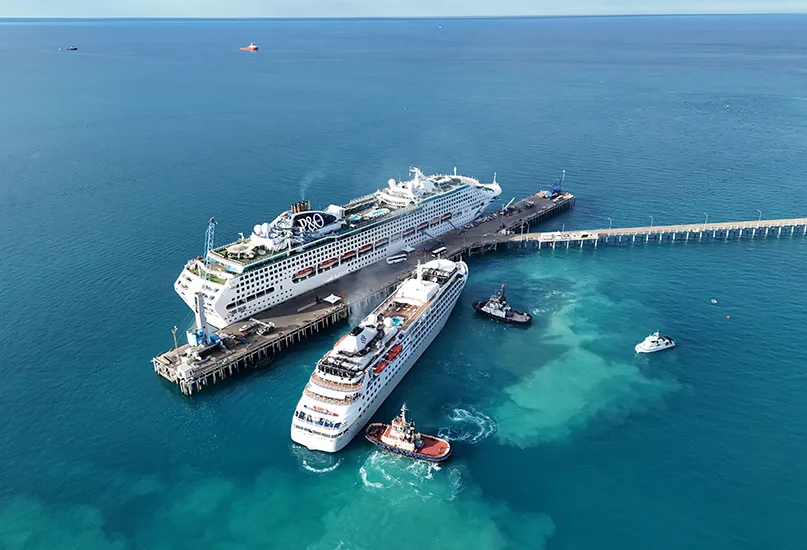
How do you support Australian ports to be sustainable and efficient gateways to international and national trade?
MG: Ports Australia works closely with our members to advance initiatives around sustainability and emissions reduction. Recently, we released a first-of-its-kind document, Greenhouse Gas Emissions Guidance for Ports, to assist ports in creating practical plans to decarbonise. This guidance was developed with support from Worley Consulting and provides a comprehensive, easy, and explicit understanding of how Australian ports can quantify and report on Scopes 1, 2, and 3 greenhouse gas emissions.
When we brought everyone together to talk about emissions reporting, we expected Australia could simply adopt something already being done internationally. However, we discovered that nothing out there matched what we needed – something flexible but consistent for all Australian ports to use as a reference point.
Instead of copying a standard, we created a guideline that offers clarity and national consistency. Although every port is unique, they all face similar challenges, and one of the biggest ones was defining the boundary of responsibility. Should we stop at the edge of the port or further down the supply chain? Getting alignment on this was crucial, which is what we’ve done with this guidance.
When consulting on this project with our ports, particularly our Climate Change and Decarbonisation subcommittee, there wasn’t a lot of conflict, just a strong desire to understand and not be left behind. Our guidance doesn’t set strict limits. Instead, we’ve created a ‘minimum floor height’ – a baseline everyone should aim to meet. Ports can go above that as they see fit, but now at least they know what everyone else is doing. It gives confidence and consistency, both internally and when reporting to the government. This report clearly holds value beyond Australian shores; in particular, it provides a strong reference point for those starting on this journey.
As Australia moves towards a net zero economy, decarbonising port operations not only helps meet environmental targets but also enhances Australia’s economic resilience, ensuring our ports remain internationally competitive in an increasingly green-conscious global market. Guidance like this will help ensure Australia’s ports are equipped to meet the evolving demands of global trade whilst contributing to a sustainable future.
What about your mission to provide leadership, advocacy, and support in areas of common interest related to Australian ports?
MG: At Ports Australia, we’re proud to act as a united voice for the nation’s ports on the big issues that matter. Our role is about supporting our members and the broader maritime sector by taking the challenges and initiatives from industry directly to both state and federal governments. It’s about shaping policy that improves not just the efficiency of ports but the resilience of the entire supply chain.
We have ongoing conversations with government departments, regulators, and ministers on a wide range of topics, from border protection and environmental management to maritime jobs and trade sustainability. Our goal is always to ensure that the ports sector remains safe, efficient, and forward-thinking. One of our latest steps in building those connections has been the creation of Parliamentary Friends of Ports, a group which gives our members more direct access to key decision-makers in Canberra.
Collaboration is key. Whether it’s working with federal and state governments or other industry bodies, we’re focused on building the right policy settings for a strong, sustainable maritime future.
Our leadership doesn’t stop at Australia’s borders, as we’re also working across the Pacific to help build maritime capacity and resilience in communities facing very real climate and economic pressures.
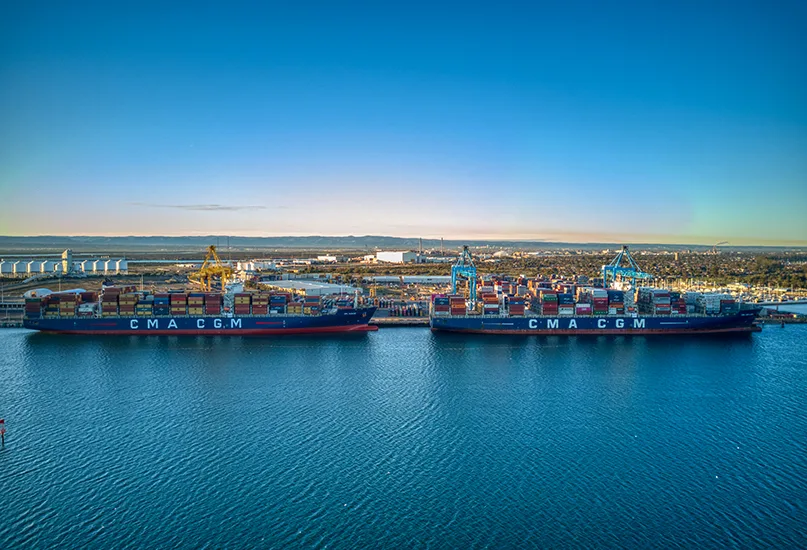
In what ways does Ports Australia bring together various stakeholders to remain at the forefront of environmental, safety, and security matters?
MG: Our organisation provides a platform for members to participate in technical committees, where they can engage in discussions on a broad spectrum of issues that are local, regional, and national. Our committees are a great space for people to come together, share ideas, and collectively work through challenges. It’s all about learning from each other, finding practical solutions, and ensuring we’re all improving together across the ports network.
By harnessing the collaborative power of these committees, Ports Australia has been able to develop national safety protocols, publish best practice environmental reporting guidance, and identify common emerging threats to the sector, such as the need for international guidance on lithium battery safety in shipping.
Importantly, our associate members are invited to be a part of these committees. They aren’t port entities but represent our various service providers linked with the maritime sector, such as stevedores, towage providers, engineers, and environmental specialists. It’s important for us to harness their expertise across the entire operation of our ports and supply chains to work together on outcomes for our sector.
I mentioned earlier that the Greenhouse Gas Emissions Guidance document is a successful output from our committees. Our flagship Wharf Structures Condition Assessment Manual (WSCAM) is also an excellent example of our committees in action. The WSCAM is an industry-leading resource that helps asset managers conduct consistent and reputable inspections and is designed to enhance data collection and align asset owners with a consistent approach to infrastructure management in Australia.
These are just some of the ways Ports Australia is bringing our ports and industry providers together to enhance the sector.
Our committees encompass various aspects of running a port and address a wide range of functions, including:
- Corporate affairs and communications
- Cybersecurity
- Engineering and asset management
- Environment, planning, and sustainability
- Logistics
- Port operations
- Port security
- Work health and safety
Ports Australia is also proud to collaborate on an international level. Through our engagement with Pacific Island port authorities and global networks like the International Association of Ports and Harbors (IAPH), we ensure Australia remains on the cutting edge of global standards and innovation. Our international counterparts have identified cybersecurity as a major threat to ports, so we play a strong role in keeping informed on this issue as it evolves on a global scale.
How does Australia’s strategic geographic position provide a distinct advantage?
MG: Australia’s position at the crossroads of the Indian and Pacific Oceans is strategically vital, not just for trade but for regional security and connectivity.
Our ports serve as linchpins in global supply chains, especially between Asia, North America, and Oceania. It’s now more important than ever to maintain connections to our international trading environment.
Ports Australia is leveraging this by building stronger ties with regional partners in the Pacific, championing shared infrastructure investment, and promoting digital and green transformation as part of our broader regional engagement strategy. This includes dialogue with Pacific port authorities seeking to build climate resilience, share skills, and improve safety standards. We see this not just as a moral obligation but a strategic priority for regional stability, prosperity, and shared environmental stewardship.
“Our ports serve as linchpins in global supply chains, especially between Asia, North America, and Oceania. It’s now more important than ever to maintain connections to our international trading environment”
Mike Gallacher, CEO, Ports Australia
Are you optimistic about the future of the ports and logistics industry throughout Australia?
MG: I’m very optimistic. Yes, the challenges are real for our ports, such as climate change, geopolitical uncertainty, and cyber threats, but there are also enormous opportunities.
Australia’s ports are adapting quickly. We have ports examining the potential for future fuel bunkering, investing in automation, and digitising their operations to boost productivity.
There’s a renewed focus from our ports, towage operators, pilots, and engineers on training and upskilling the next generation of port sector professionals. The fact that ports are now central to both climate and economic policy shows just how much potential this sector holds. I am excited to see further collaboration with our international counterparts on the big issues impacting ports globally. I’m also keen to see Ports Australia produce a future iteration of State of Trade, which will paint a picture of our evolving import and export markets and how ports continue to invest in building Australia.
Finally, what are Ports Australia’s goals and priorities, and what strategies will you employ to facilitate and implement them?
MG: Our strategic priorities are shaped by our board and reflect the big national issues facing ports today.
Since our last feature in AO, some of those priorities have evolved, whilst others, like decarbonisation, safety, workplace skills, and resilience, are still right at the top of the list. Security remains a major focus, too. That said, we’re also very responsive to emerging issues. Things can change quickly in this sector, so we remain flexible and ready to tackle new challenges as they arise.
Looking ahead, one of the big things on our radar is our BizOps Conference in Gladstone later this year. It’s a great opportunity to bring together the operational professionals who keep our ports running and dive into the latest innovations in the sector. Events like this and our Biennial Conference are a huge part of how we stay connected and collaborate with the wider ports and maritime community, not just across Australia but internationally as well.
We’ve been fortunate to have delegates from our Pacific port members join us, along with leaders from the IAPH and European ports. It’s been fantastic to exchange ideas and strengthen those relationships.
We’re continuing to work closely with government on how we can better engage with our neighbours and build a stronger regional network across Oceania. New Zealand has played a key role in that, and we’re pleased to now have several New Zealand ports as members.
Beyond that, we’re working closely with our committees on new resources and projects aimed at improving the sustainability and resilience of our ports. It’s all about ensuring we’re setting the sector up for long-term success.
I’m looking forward to reporting back on the success of these projects in a future AO feature.
PORTS AUSTRALIA PARTNERS





